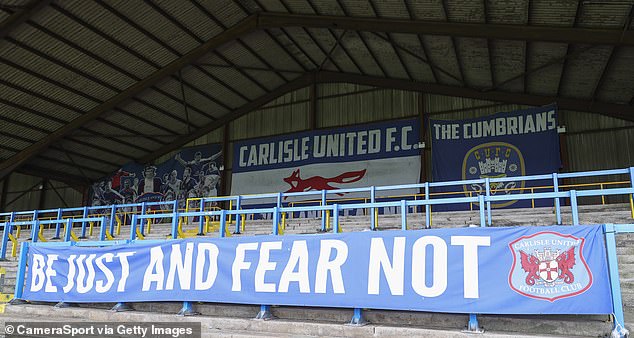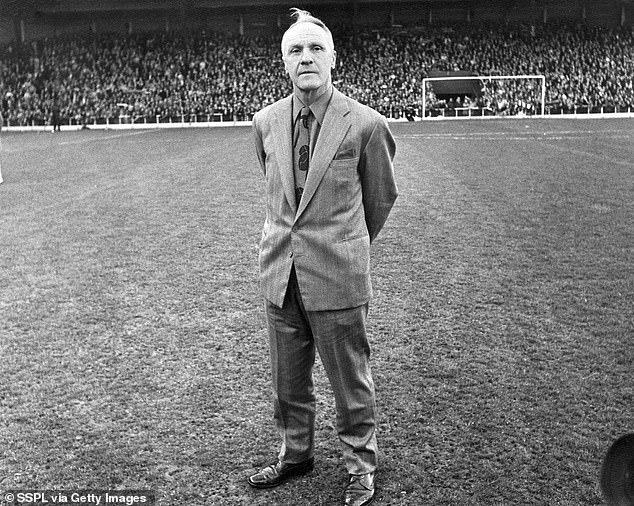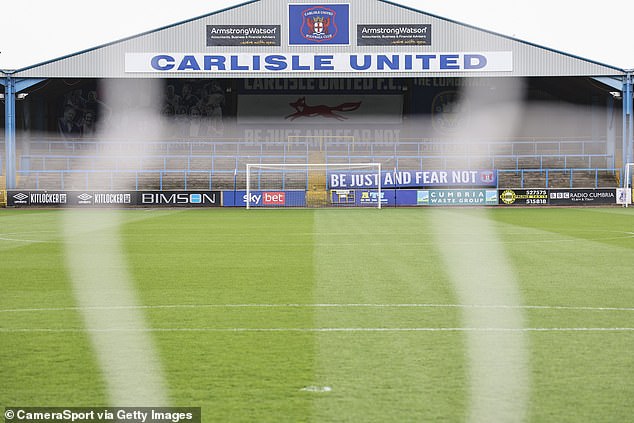Bill Shankly called it “the greatest feat” in football and half a century after Carlisle United’s promotion to the top tier it is still under scrutiny.
Perhaps it was the scale of improbability, the audacity of such a modest club or the added drama of the false ending.
Whatever it is, the return to the EFL’s basement as the 50th anniversary approaches has an emotional resonance.
The new American owners promise investment and better times ahead, but their first full season at the helm will begin a far cry from the heady heights of April 1974.
That was the month in which Cumbria first became a county, an amalgamation of Cumberland and Westmorland. Terry Jacks topped the charts with ‘Seasons in the Sun’, which proved prophetic, and Carlisle ended their best campaign with a 2-0 win against Aston Villa.
Carlisle United are back in the lower tier of the EFL after their relegation from League One

Their relegation comes 50 years after Carlisle were promoted to the First Division.
Goals scored by Joe Laidlaw and Frank Clarke in front of almost 12,500 people at Brunton Park.
“We thought we were on top,” John Gorman recalls. “We were hugging each other, lifting each other up. Celebrating on the court. Then we realized we weren’t up and had to wait for Orient.
Carlisle finished third and this was the first time that three teams would be promoted from the second tier of English football.
Until then, only the first two had been there. They knew this well. They had finished third without reward in 1965/66, during the first period under Alan Ashman, a manager who later went to West Bromwich Albion, where they won the FA Cup, and Olympiacos in Greece, before returning to Carlisle in 1972.
Ashman worked closely with Dick Young, the club’s long-serving coach and then director. “Alan left the coaching to Dick,” says Gorman, whose long coaching career included stints as assistant to Glenn Hoddle at England and Tottenham.
‘Dick wanted to pass, pass, pass, pass, pass. We were a push and run team. We would spend all our time working on skills, repetitive exercises, practicing with both feet. Dick was one of the best. I based a lot of my training on what I had learned from him.
‘Alan spent most of the day in his office. He would go out for 10 minutes in his big sheepskin coat, look at us and come back in. We wondered what he was doing, but he was signing players and building the team.”
Ashman put together a good team, led by his inspiring young captain Bill Green at the heart of the defence. Allan Ross was a legend in goal, amassing a record 466 appearances for Carlisle. Peter Carr, contusion on the right side. Gorman, an attacking force at left back.
There was Les O’Neill, Stan Ternent, Ray Train and Graham Winstanley. There was the versatile Chris Balderstone who, two months after that victory against Villa, was Leicestershire’s top scorer in the Benson and Hedges Cup final at Lord’s.
Two years later, Balderstone was facing the West Indies pace attack on his Test debut. Meanwhile, in September 1975, after moving to Doncaster Rovers, he took part in competitive matches in both the County Championship and the Football League on the same day.
He was not 51 offside after the first day’s match against Derbyshire at Chesterfield, drove to Belle Vue for a 1-1 draw against Brentford, then returned to complete his century the next day (116 was left) and took three of 28 as Leicestershire won by 135 runs and took the county championship title.
Carlisle had a variety of attacking options. Bobby Owen, Dennis Martin, Laidlaw and Clarke. “So many goals on the team,” Gorman says.
They finished third after beating Villa, but Leyton Orient still had one to play, also against Villa, the following Friday. Orient were two points behind and it was two points to win, but they had a better goals average so any win would take them into third place and dislodge Carlisle.
Almost 30,000 people gathered expectantly on Brisbane Road, and the number was swelled by quite a few trespassers.
“More hope than expectation,” admits Malcolm Fawcett, one of those in the visiting camp, cheering Villa on with his blue and white scarf. “With Carlisle it’s usually the hope that kills you, but the expectation seemed to get to Orient.”
Another remembers that the home team ran out with bunches of gladioli in their arms. “They handed them out to the crowd before the game,” says 80-year-old Harold Bowron. “I remember thinking, ‘I wouldn’t do that.’ I would have saved it until the end.
Some Carlisle players and staff attended the game, others gathered at the Cumberland News offices. In the end, it turned out to be a night of joy for them and despair for Orient, who fought back from a goal down to equalize but could not find a winner.
Carlisle was up. Jubilant fans made their way from Brisbane Road to Trafalgar Square and celebrated with supporters of Liverpool and Newcastle, who were in London for the FA Cup final.
In an interview ahead of the final at Wembley, Shankly, who began his managerial career at Brunton Park, said: “Let me tell you about my old club, Carlisle United, who were promoted to the top division for the first time last night.” “That’s the greatest feat in the history of the game.”

Bill Shankly, who played for and managed Carlisle, said the club’s promotion to the top flight was “the greatest feat in the history of the game”.
The London branch of the Carlisle supporters club emerged from that euphoric night and is still going strong. Forty years later, they made T-shirts with the quote.
Gorman still has his own and is unwilling to disagree with Shankly, even though he and Hoddle took Swindon Town to the Premier League in 1993. “Very similar,” says the 74-year-old. “A good group of players, good personalities and attractive football.”
Carlisle topped Division One three games into the following season, with wins against Chelsea, Middlesbrough and Tottenham, but were relegated, never to return.
At least not yet. They have not surpassed the third level since 1986. The season in the sun is a fading memory in the border city, but those who were there will not forget the achievement or its magnitude.
Promotion specialist Challinor triumphs again
Dave Challinor was appointed player-manager at Colwyn Bay in the Northern Premier in May 2010, the same month Stockport County were relegated from League One.
Since then Challinor has won promotion seven times. First with Colwyn Bay, three times with Fylde, once with Hartlepool and on Saturday for the second time with Stockport, completing their journey back to League One.

Dave Challinor sealed his seventh promotion as manager by taking Stockport to League One


